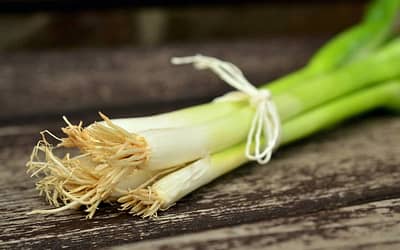The Wisteria Floribunda, originally introduced to the United States from Japan in 1860, has captured hearts with its timeless charm. Renowned for its cascading purple blooms and elegant presence, this iconic plant has transformed from adorning pergolas and arbors to taking center stage as a stunning bonsai.
The Wisteria Bonsai is a beautiful miniature tree with glossy green leaves that turn golden in autumn and fragrant, pea-like flowers. In full bloom, it radiates sentimental and natural beauty.
What is Bonsai?
Bonsai, the art of replicating natural tree forms in miniature, is a centuries-old tradition rooted in Japan and China. These delicate trees, grown in pots, rely entirely on their caretaker for proper nurturing.
With the right attention and care, your bonsai can thrive, staying healthy, stunning, and compact for many years. As a living work of art, a bonsai only becomes more captivating with age, growing in beauty and character as it matures over time.
How to Grow Wisteria Bonsai
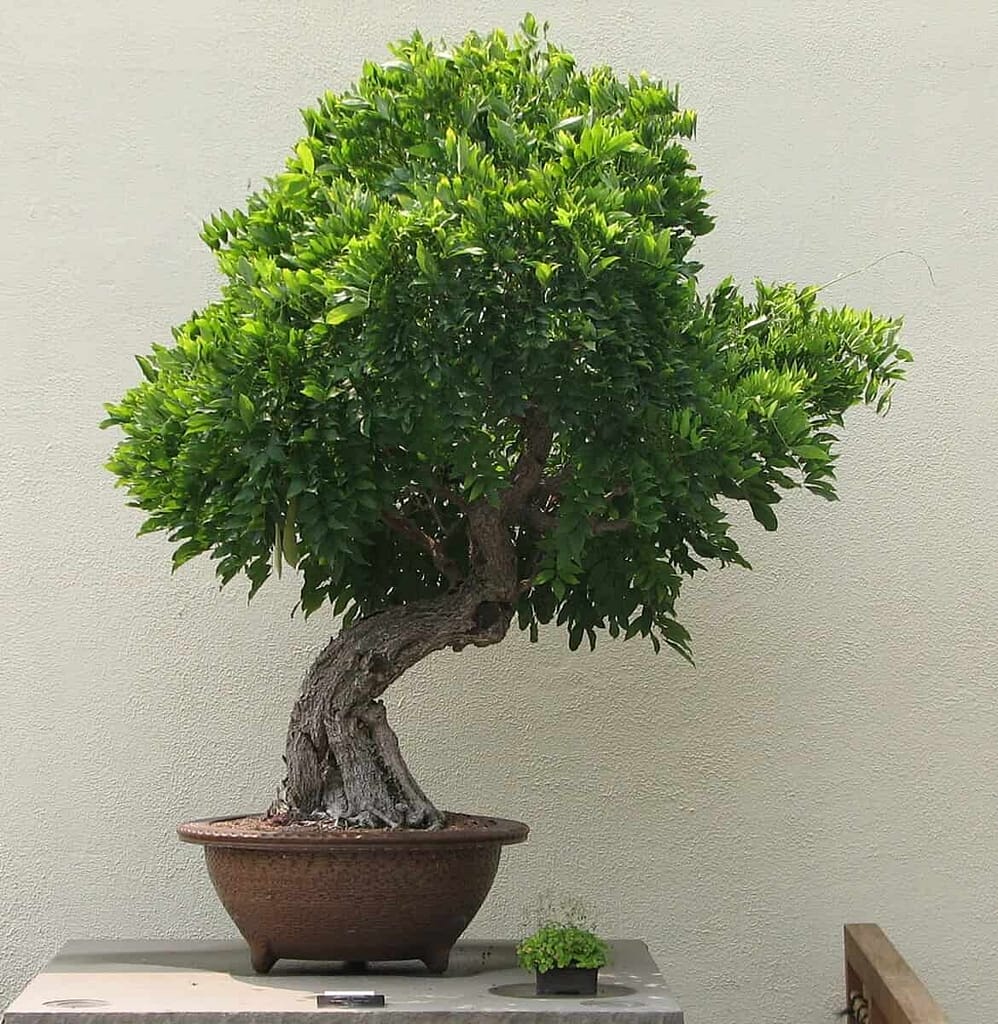
Ragesoss, Japanese Wisteria, 1925-2007, CC BY-SA 3.0
Wisteria bonsai can be cultivated from seeds, seedlings, or divisions, each method having its own advantages and disadvantages.
From Seeds
Pros: It’s a rewarding long-term project that allows you to shape the tree from the beginning.
Cons: It takes a very long time (10-15 years) for the tree to mature and flower. Germination can be tricky, and the seedlings are delicate and require careful nurturing.
From Seedlings
Pros: This is a faster option than growing from seed, as the seedlings are already established. You can start shaping the tree sooner.
Cons: Finding healthy Wisteria seedlings can be challenging, and they may still take several years to mature.
From Divisions
Pros: This is the fastest way to get a flowering Wisteria bonsai. Divisions are mature sections of a larger Wisteria plant, so they can flower sooner.
Cons: Divisions can be more difficult to find and may be more expensive than seedlings or seeds.
Nurturing a Wisteria Bonsai from Seed
Growing a Wisteria bonsai from seed is a rewarding, albeit time-consuming, endeavor. It’s a journey that requires patience and a keen eye for detail. Here are a few simple steps to start with:
Step 1: Harvest the Seeds
Timing is Key: Harvest the seeds from a mature Wisteria plant once the pods have turned brown and dry.
The Sound Test: Shake the pod. If it rattles, the seeds are ready.
Step 2: Test for Viability
The Sink or Swim Method: Place the seeds in a bowl of water. Viable seeds will sink to the bottom, indicating they are ready for planting.
Step 3: Scarification (Optional)
A Helping Hand: To aid germination, gently nick the seed coat with a sharp blade or a file. This weakens the outer layer, making it easier for the seedling to emerge.
Step 4: Prepare the Soil
A Perfect Start: Fill a pot or seed tray with a well-draining, soilless seed-starting mix.
Step 5: Sowing the Seeds
Plant with Care: Sow the seeds on the soil surface, covering them lightly with a thin layer of soil.
Ideal Conditions: Place the pot in a warm, well-lit location.
Step 6: Maintain Moisture
A Hydrated Start: Keep the soil consistently moist, but avoid overwatering. A daily misting can help maintain humidity.
Step 7: Transplanting the Seedling
A New Home: Once the seedling has developed a few sets of true leaves, transplant it into a shallow bonsai pot filled with well-draining bonsai soil.
Remember, patience is key when growing Wisteria bonsai from seed. It may take several years for your seedling to mature into a beautiful bonsai tree.
Nurturing a Wisteria Bonsai from Seedlings
Growing a Wisteria bonsai from a seedling is a more direct approach than starting from seed. While it may still take several years to develop into a mature bonsai, it offers a head start.
Step 1: Acquiring Seedlings
Nurseries and Online Retailers: Purchase healthy Wisteria seedlings from reputable sources.
Division: If you have a mature Wisteria plant, you can propagate new plants through division.
Step 2: Selecting the Right Pot
Shallow and Wide: Choose a shallow, wide bonsai pot with drainage holes to accommodate the Wisteria’s root system.
Well-Draining Soil: Use a well-draining bonsai soil mix to prevent root rot.
Step 3: Planting the Seedling
Gentle Handling: Carefully remove the seedling from its nursery pot, ensuring minimal root disturbance.
Proper Placement: Position the seedling in the pot, ensuring it’s upright and stable.
Backfilling: Fill the pot with the bonsai soil, gently pressing it down around the roots.
Watering and Fertilizing
Regular Watering: Water the seedlings regularly, keeping the soil consistently moist but not soggy.
Fertilizing: Apply a balanced liquid fertilizer diluted to half strength during the growing season.
Pruning and Shaping
Initial Pruning: Once the seedling has established itself, begin pruning to shape the tree.
Wiring: You can make use of aluminum wires for bending and shaping the tree branches.
Pinching: Pinch new growth to encourage branching and bushier growth.
Winter Care
Dormancy: Wisteria bonsai requires a period of dormancy during winter. Reduce watering and place the tree in a cool, protected location.
Remember, patience is key when growing a Wisteria bonsai. By following these steps and providing optimal care, you can nurture a beautiful and unique bonsai tree.
Caring for Wisteria Bonsai Trees
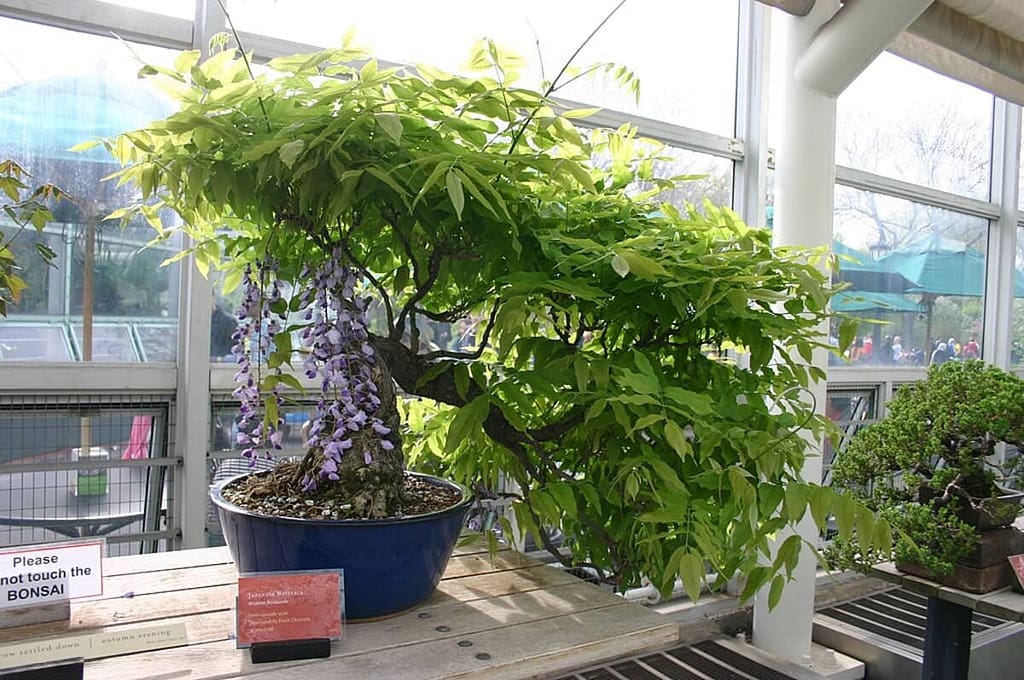
Ryan Somma, Bonzai Japanese Wisteria, CC BY 2.0
Preparing for Winter Dormancy
As the colder months approach, your Wisteria bonsai will enter a period of dormancy. This is a natural process that helps the tree conserve energy and prepare for the upcoming growing season.
Winter Storage Options
Outdoor Burial:
Burying: Carefully bury your bonsai (without the pot) in a sheltered location, such as a garden bed or a raised bed.
Mulching: Cover the buried pot with a layer of mulch to protect the roots from extreme cold.
Protection: Choose a spot that is protected from strong winds and direct sunlight, but exposed to rain and snow (Excessive snow can be damaging, so some protection during heavy snowfall might be necessary.)
Indoor Storage:
Cool, Dark Location: Place your bonsai in an unheated garage, shed, or basement.
Minimal Watering: Water your bonsai sparingly, approximately every 2-3 weeks.
Spring Awakening
As temperatures begin to rise in spring, it’s time to awaken your Wisteria bonsai from its winter slumber. Gradually introduce it to warmer conditions and increase watering frequency.
Summer Care
During the summer months, your Wisteria bonsai will thrive outdoors. Place it in a location that receives ample sunlight, such as a patio or balcony. Ensure it receives adequate water and fertilizer to support its growth and flowering.
Indoor Display
While it’s tempting to keep your bonsai indoors for extended periods, it’s important to limit indoor displays to special occasions. The dry indoor air can be detrimental to the tree’s health. When displaying your bonsai indoors, choose a well-lit location and mist the foliage occasionally to increase humidity.
By following these guidelines, you can ensure that your Wisteria bonsai remains healthy and beautiful for years to come.
Other Maintenance Needs
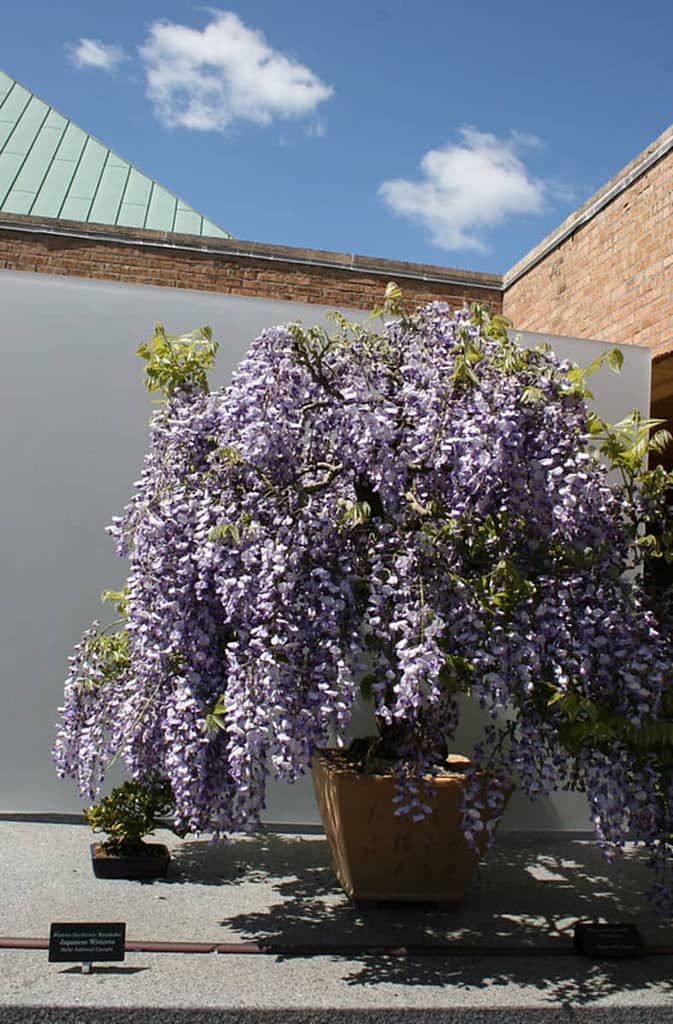
Photo by Quinn Dombrowski (CC BY-SA 2.0)
Watering Your Wisteria Bonsai
Consistent Moisture: Ensure the soil remains consistently moist, but avoid overwatering. Regularly monitor the soil’s moisture levels, particularly during hot and dry periods.
The Right Technique: Water your bonsai slowly and deeply, ensuring that the water drains through the pot’s drainage holes.
Seasonal Adjustments: Modify your watering schedule according to the season and your bonsai’s specific needs. Water less frequently during the winter.
Humidity and Your Wisteria Bonsai
Humidity Boost: To increase humidity, especially during dry winter months, place your bonsai on a tray filled with pebbles and water. The evaporation of the water will create a humid microclimate around your bonsai tree.
Fertilizing Your Wisteria Bonsai
Nutrient Boost: Fertilize your bonsai regularly during the growing season (spring and summer) to provide essential nutrients.
Balanced Fertilizer: For your bonsai tree, use a balanced, water-soluble fertilizer, diluted to half its actual strength.
Foliar Feeding: Consider foliar feeding, where you spray a diluted fertilizer solution on the foliage, to provide additional nutrients.
Training Your Bonsai
While basic care is essential, the art of bonsai lies in its training. Shaping and styling your Wisteria bonsai involves techniques such as wiring and pruning. This is a complex process that requires patience, skill, and often, professional guidance.
However, most bonsai trees you purchase have already undergone initial training. Your role will be to maintain their shape and size through regular maintenance.
Trimming and Pinching
Selective Pruning: Trim back new growth to maintain the desired shape and size.
Pinching: Pinch off new shoots to encourage branching and a denser growth habit.
Timing is Key: The frequency of trimming and pinching will vary depending on the species and the specific growth rate of your bonsai.
Maintenance and Care
Regular Inspection: Regularly inspect your bonsai for pests, diseases, and signs of stress.
Repotting: Repot your bonsai every 2-3 years to refresh the soil and prune the roots.
Winter Care: During the winter, move your bonsai to a cool, protected location and reduce watering.
By following these guidelines, you can ensure that your Wisteria bonsai thrives and remains a beautiful addition to your home or garden.
Repotting Your Wisteria Bonsai: A Step-by-Step Guide
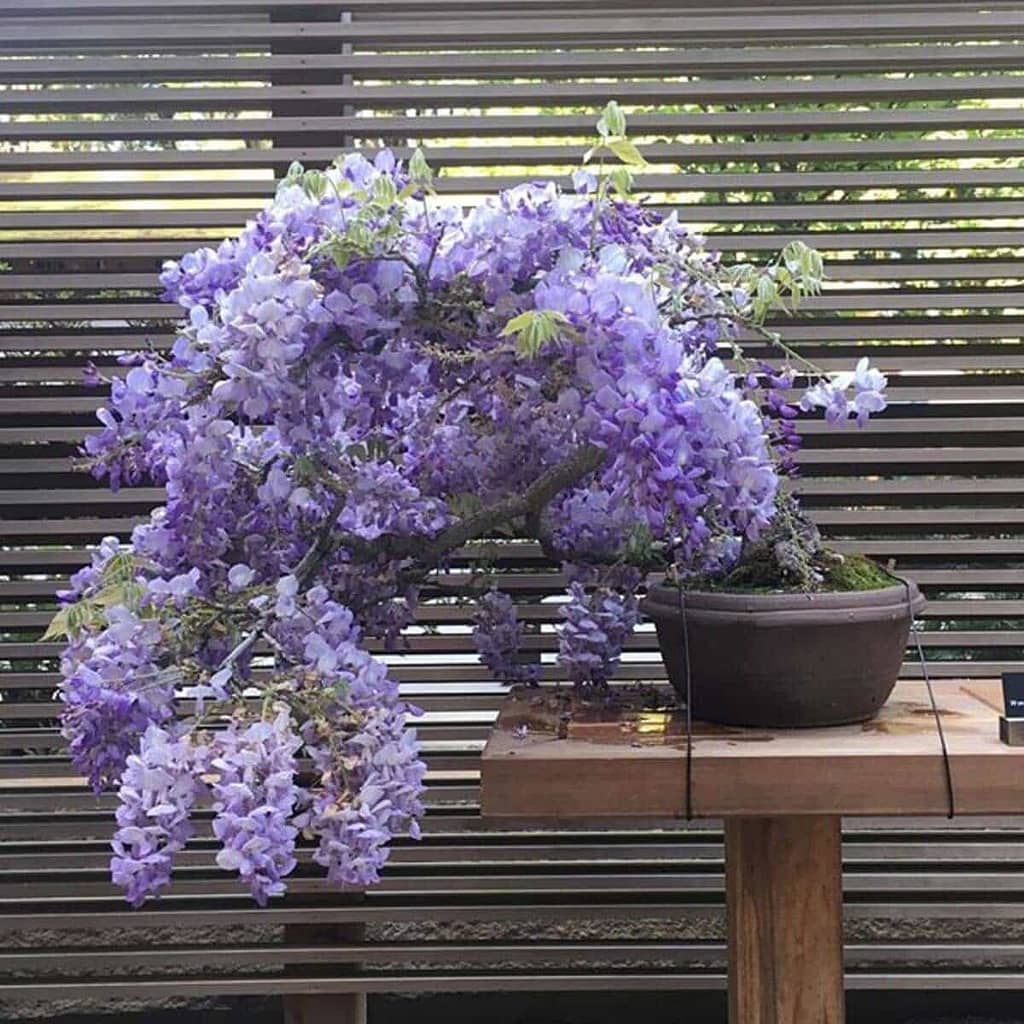
Photo by evan p. cordes (CC BY 2.0)
Repotting is a crucial part of bonsai care, ensuring your tree thrives in a healthy environment. Over time, a bonsai’s roots will fill its pot, signaling the need for repotting to provide fresh soil and encourage a compact root system.
When Should You Re-pot?
The frequency of repotting depends on the type of tree. Deciduous trees typically require repotting every 2–3 years, while evergreens need it less frequently—every 4–5 years. However, since growth rates vary, it’s essential to examine your tree’s root system annually to check if it’s becoming pot-bound.
How to Repot Your Wisteria Bonsai Tree
If done correctly and at the right time—usually mid-summer—repotting is a straightforward and safe process. Here’s a step-by-step guide:
Prepare Your Tree
Carefully remove the tree, along with its soil, from the pot.
Trim the Roots
Gently rake away soil from the outer and bottom portions of the root mass. Prune back up to one-fourth of the roots, but avoid exceeding this limit to ensure the tree’s health.
Prepare the Pot
Place screens over the drainage holes to prevent soil loss.
Add a thin layer of small gravel for drainage.
Add a layer of fresh, well-draining soil in the pot to raise the tree to its original height.
Replant the Tree
Place the tree in the pot and fill the gaps left by the trimmed roots with fresh soil. Gently work the soil around and beneath the root system to remove any air pockets.
Water Thoroughly
Submerge the entire pot in a tub of water to ensure the soil is saturated and the tree is well-hydrated.
Add Finishing Touches
To prevent soil erosion during watering, you can cover the soil surface with moss or other ground covers.
A Healthy Future for Your Bonsai
With proper repotting, your bonsai will continue to flourish, showcasing its beauty and vitality. Regular maintenance like this not only supports the tree’s growth but also strengthens your connection with the timeless art of bonsai care.
Common Pests and Diseases
Although Wisteria bonsai are typically hardy, they can still fall prey to specific pests and diseases. Below are some common problems and different ways to handle them:
Diseases
Powdery Mildew: This fungal infection appears as a white, powder-like layer on the leaves. To combat it, improve air circulation, avoid overhead watering, and consider using a fungicide.
Creating dark brown or black spots on the foliage, this fungal infection weakens the plants. To manage it, remove the affected leaves and enhance air circulation around the plant
Crown Gall and Cankers: These bacterial infections can cause swelling at the base of the trunk or lesions on branches. Prune out affected areas to prevent the spread of the disease.
Root Rot: Excessive watering or poorly draining soil can cause root rot. Ensure good drainage and modify your watering routine accordingly.
Pests
Wisteria Borer: This destructive pest bores into the trunk and branches, causing significant damage. Unfortunately, controlling the Wisteria borer is difficult, even with chemical pesticides. Early detection and removal of infested branches may help limit the damage.
By being vigilant and taking preventative measures, you can help keep your Wisteria bonsai healthy and thriving.
Frequently Asked Questions
Yes, wisteria can be cultivated as a bonsai and is especially admired for its stunning flowers. Its charm shines brightest during the blooming season, but once the flowers fade, the plant’s leaves and tendrils can overshadow the trunk and branches. Despite this, wisteria is a popular choice among bonsai enthusiasts for its spectacular floral display.
Yes, wisteria can be grown indoors in a container. While it thrives in sunlight, keeping it indoors helps prevent drying out, reduces the need for frequent fertilization, and allows for better support and control of its growth.
Chinese wisteria features slightly larger, fuller flowers, while Japanese wisteria is known for its longer, more fragrant blooms. Both types make stunning bonsai, with Japanese varieties like Wisteria floribunda ‘Rokushaku’ being especially popular for their elegance.
Wisteria bonsai symbolizes love, good fortune, and new beginnings. In Chinese culture, it has been cherished for centuries, often featured in gardens to mark the arrival of spring.
Yes, wisteria seeds and pods are toxic to cats. Ingestion can lead to severe dehydration, damage to the central nervous system, vomiting (sometimes with blood), and issues with blood clotting. Keep wisteria plants out of reach to ensure your cat’s safety.
Curious Contemplations
Bumblebees: Guardians of Biodiversity
Click Beetles: Nature’s Spring-Loaded Marvels


